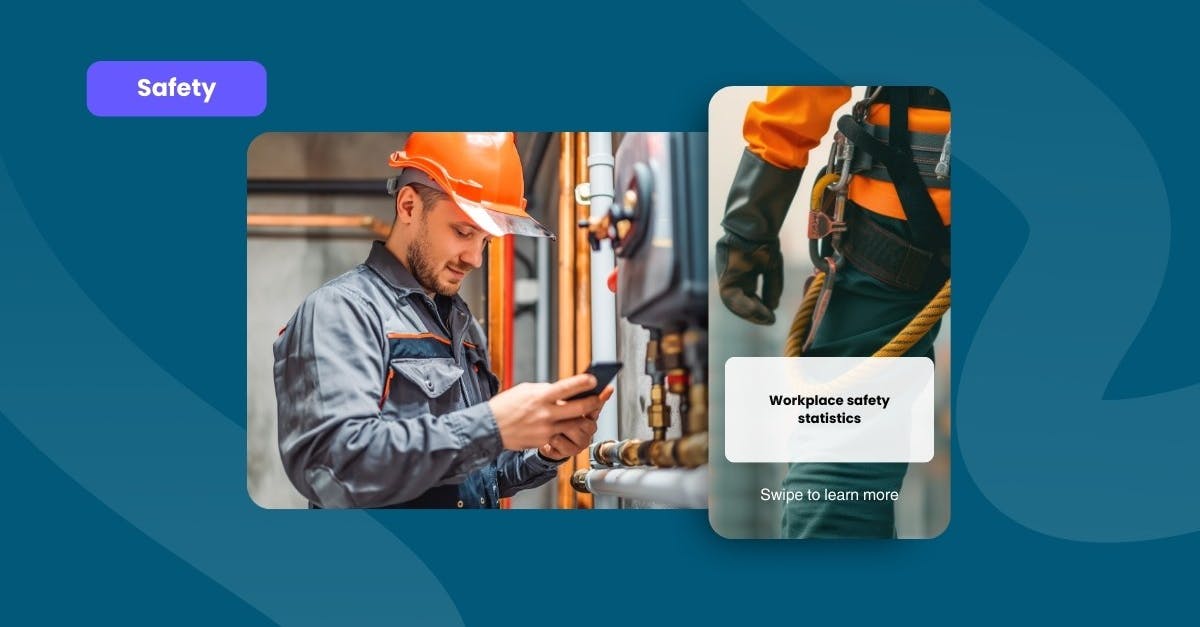Top 10 workplace safety statistics of 2024

The workplace should always be a safe space for employees to thrive. If occupational health and safety are the driving force of every organization, there’s a lesser chance of employees facing hazards at work.
Discover the latest patterns and trends through this list of workplace safety statistics. These will help you manage and predict risks confidently, enhancing the overall operational efficiency of your business.
What are safety statistics and why are they important?
Safety statistics is a systematic collection of data that notes the frequency of casualties, injuries, and accidents across different industries. It offers businesses reliable and timely information on the current trends and affairs concerning occupational health and safety worldwide.
Each year brings many changes in the workplace. With increasing physical to mental hazards, employees deserve to work for a company that genuinely cares about their well-being. This is why safety statistics play a crucial role in workforce management.
It nurtures a safety culture from within and yields several benefits for employers. Safety statistics can help you conduct risk management, meet compliance standards, and inform your company’s training programs.
10 Workplace safety statistics
Explore why occupational health, safety, and compliance should be non-negotiables in your business. We’ve rounded up 10 workplace safety facts that you should take note of in 2024.
Companies spend more than 1 billion USD on workplace injuries every week
From construction to healthcare, retail, transportation, and manufacturing, the global insurer, Liberty Mutual, reports an alarming health and safety fact. Workplace injuries cost US businesses over 1 billion USD weekly. In a year, this amounts to more than 58 billion USD in expenses.
The list of top ten common workplace injuries includes heavy loads, wet floors, wobbly ladders, and moving machinery. Without proper safety guidelines, any workplace can become a haven for several hazards.
18,000 machine operators experience serious injuries annually
While industrial machines save countless hours of manual labor, they can cause serious injuries and fatalities if your workers aren’t careful. The Occupational Health and Safety Administration (OSHA) reports that over 18,000 machine operators suffer from crushing injuries, amputations, lacerations, and abrasions in the US per year.
These incidents happen mainly because of limited training, compliance issues, employees taking shortcuts, or poor equipment maintenance. Because machines vary according to their type and size, it’s important to add machine guarding training to your safety tips for work. You should also verify that each worker is familiar with their day-to-day assignments.
Fall protection tops OSHA’s list of violations in 2023
After thoroughly inspecting worksites across industries, fall protection ranked first on OSHA’s list of the Top 10 Most Cited Standards in 2023, with over 7,188 recorded violations in the US.
Fall hazards are anything that triggers the loss of body support or balance, like unguarded roof openings, leading edges, and structural steel. Construction workers are the most prone to this, so consider investing in another layer of safety training to avoid collecting OSHA violations.
Over 1 billion workers suffer from exposure to hazardous substances yearly
When it comes to chemical safety, you shouldn’t be complacent. The International Labor Organization notes that over 1 billion workers are exposed to hazardous substances—like fumes, dust, pollutants, and vapors—each year.
Exposure to hazardous chemicals has lasting health implications, so extra care and vigilance are required. While your workers may not be strangers to chemical handling, it’s always better to double down on their safety through proper hazard communication and spill response training.
More than 100,000 lives are lost to asbestos exposure every year
Did you know that over 100,00 lives are lost to asbestos exposure every year? The International Labor Organization proposes that this number will continue rising if efforts aren’t made to outlaw its commercial use globally.
While attempts to outlaw the use of asbestos began as early as the 1970s, it was only in March 2024 that the US finalized its ban on chrysotile asbestos, the most commercial form of asbestos.
Invisible to the human eye, asbestos is a natural mineral resistant to electricity, heat, and corrosion. Before it was found to cause several lung diseases and cancer, asbestos was often used in the manufacturing, automotive, and construction industries.
1 in 10 people suffer from food contamination each year
Food safety is a worldwide concern. The World Health Organization reports that 1 in 10 people get sick from consuming contaminated food annually. If not kept in check, foodborne illnesses could lead to long-term disability and even death.
This is why government agencies strictly enforce regulations to make sure every business stays compliant. Remember, the fast-paced demands of your industry should never be a reason to downplay your customers’ safety! More than meeting industry standards, proper food handling enhances consumer satisfaction, protects your business’ reputation, and maximizes cost savings.
86% of employees believe employers can do more for their mental health
Workplace safety goes beyond physical protection from harm. It means prioritizing your workers’ mental health too. In Traliant’s 2024 Employee Survey Report, the compliance training expert found that 86% of US-based workers believe companies should create more mental health initiatives.
Indeed, it’s hard for employees to perform their jobs properly when they feel anxious coming to work every day. As an organization, you must watch out for common psychosocial hazards, like high job demands, workplace bullying, and poor work-life balance. To overcome these, you can facilitate training or workshops for your employees.
Psychological safety is a driving force of effective teamwork
An ideal workplace environment allows employees to freely express their problems and concerns without being judged. According to research by the American Psychological Association, psychological safety is a key driver of satisfaction and collaboration.
This paves the way for better relationships with co-workers and enhanced productivity. It also makes them more receptive to change, as APA reports that employees with a lower sense of psychological safety remain anxious about their job security.
More than 1 in 5 employees experience workplace violence and harassment globally
Over 23% of employees worldwide claim their workplace isn’t a safe space. According to the multinational advisory company Gallup, more than 1 in 5 have suffered from violence and harassment. In broader terms, this accounts for about 750 million workers globally.
The three common forms are psychological, physical, and sexual. Gallup also adds that women are more likely to experience sexual violence and harassment than their male co-workers. Sadly, most of these employees chose not to speak up, fearing for their reputation and the lack of clear reporting procedures.
Road traffic crashes amount to over 1.19 million deaths each year
The ability to drive is a major responsibility plenty of workers take for granted. Caught in the road rush, safety turns into an afterthought. This is why every year, vehicular accidents remain one of the leading causes of major fatalities around the world.
Annually, over 1.19 million lives are lost to road traffic crashes, the World Health Organization reports. This results in a three percent loss in most countries’ gross domestic product. By teaching your workers to practice defensive driving, you can help them think one step ahead and avoid accidents on the road.
Enhance workplace safety with SC Training
Now that you’ve developed a wider understanding of this year’s top workplace safety statistics, it’s your turn to initiate the change. Most of the injuries mentioned above arise from a lack of employee training and poor management initiatives.
Luckily, there’s an all-in-one solution for your workplace safety needs. With SC Training (formerly Edapp), you can make use of these helpful features to boost employee satisfaction and stay compliant with federal regulations:
- Microlearning: The perfect solution for busy and mobile teams, microlearning breaks down essential concepts into bite-sized chunks to enhance knowledge retention among your workers. Each training course can be finished in under five minutes.
- Editable course library: The course library contains over 1,000 editable training courses. Various OSHA-compliant courses have been reviewed by industry experts from the American Society of Safety Professionals (ASSP) to make sure your team’s safety training is in good hands.
- Group training: Say goodbye to clunky attendance sheets. With this feature, you can easily track in-person attendance straight from your phone. Simply scan each member’s QR code to view their training data.
Use SC Training to enhance workplace safety and track compliance. Sign up today!
Author
Bea Maureen Cayone
Bea Maureen Cayone is a content specialist at SC Training, a leading mobile-first operations platform that provides advanced solutions for frontline training. With expertise in workforce management and workplace safety, she creates content tailored to the logistics, transportation, and energy industries. Outside of work, she enjoys reading, playing the piano, and walking her dogs.
